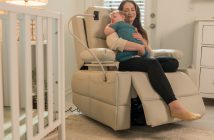If there’s one thing just about every kid throughout history is good at it’s getting messy, and your rambunctious rugrats are likely no exception to this rule. They are prone to getting into all manner of products and places they shouldn’t, spreading chaos (and Cheerios, and other detritus) in their wake like little tornadoes, and undermining any efforts you’ve made on behalf of their personal cleanliness and hygiene in the process. Since you can’t keep your eyes on them every second of every day and you’ve reached your upper limit on scrubbing them clean, perhaps it’s time to think about introducing them to a bar of soap and a washcloth and helping them learn when, how, and why it’s appropriate to observe proper hygienical practices. Here are just a few tips to get them on track.
 Your best bet when it comes to getting kids on board with forming good habits (of any kind) is to start them young, and in order to make your venture a success you should probably find ways to engineer some fun. This is easy enough for bath time; all you have to do is throw a few waterproof toys in the tub for kids to play with. Right? Actually, this may promote bad habits that are hard to break later on, such as playing in the water and wasting time when they should be washing. Instead think about getting a slew of bath products that will make cleaning part of the fun. You can find all kinds of items to fill the water with bubbles, colors, and scents and you can include fun sponges or mitts (which double as toys that attack them with soap). And don’t forget to use gentle, “no tears” products that won’t sting or burn sensitive skin and eyes.
Your best bet when it comes to getting kids on board with forming good habits (of any kind) is to start them young, and in order to make your venture a success you should probably find ways to engineer some fun. This is easy enough for bath time; all you have to do is throw a few waterproof toys in the tub for kids to play with. Right? Actually, this may promote bad habits that are hard to break later on, such as playing in the water and wasting time when they should be washing. Instead think about getting a slew of bath products that will make cleaning part of the fun. You can find all kinds of items to fill the water with bubbles, colors, and scents and you can include fun sponges or mitts (which double as toys that attack them with soap). And don’t forget to use gentle, “no tears” products that won’t sting or burn sensitive skin and eyes.
But what about getting them to attend to other hygienical needs that tiny tots often neglect, like brushing teeth, washing hands, and wiping properly? Okay, so some of these tasks may be a bit difficult for them to tackle on their own until their coordination improves, but you can certainly get them started down the right path by teaching them what to do and allowing them frequent (but supervised) practice. And if you’re not quite sure how to teach them just talk to your doctor and dentist for some instructive pointers (you don’t even need medical insurance or a Careington 500dental plan – advice is free!).
 In some cases you can make these lessons fun by stocking the bathroom with cool soaps and tasty toothpaste (try Tom’s of Maine), or adding some timed music clips to let them know how long to wash or brush. But there are certain tasks where you will really have to impress on them the importance of being thorough (wiping, for example). And if you can’t think of any creative ways to inject some fun, try setting up a daily hygiene chart (complete with stickers for completion) to help them track their hygiene-related tasks. Then offer appropriate rewards for reaching set goals.
In some cases you can make these lessons fun by stocking the bathroom with cool soaps and tasty toothpaste (try Tom’s of Maine), or adding some timed music clips to let them know how long to wash or brush. But there are certain tasks where you will really have to impress on them the importance of being thorough (wiping, for example). And if you can’t think of any creative ways to inject some fun, try setting up a daily hygiene chart (complete with stickers for completion) to help them track their hygiene-related tasks. Then offer appropriate rewards for reaching set goals.
Kids may not be particularly interested in their own state of cleanliness, but that doesn’t mean you can’t help them to develop good habits where their hygiene is concerned. And since you want them to be healthy, happy, and squeaky clean (and you have to live with them whether they are or not) it behooves you to find ways to get them on board with seeing to their own hygienical needs at some point.
Author: Sarah Danielson is a freelance writer and part time student. In her spare time she likes to go hiking and help with an animal rescue out of Los Angeles, California.




